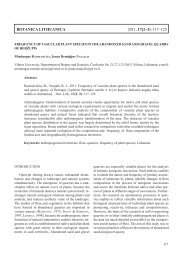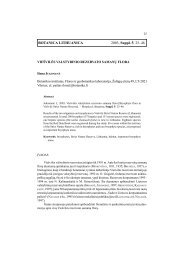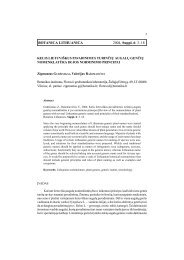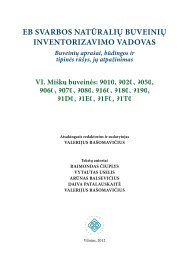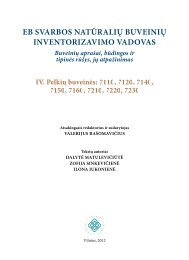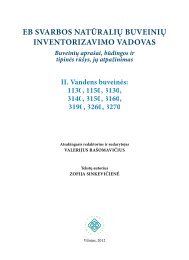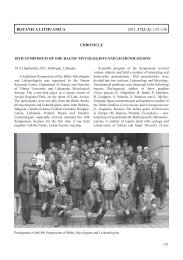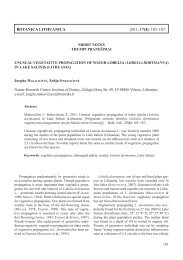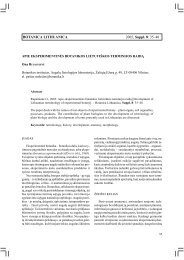FUNGI AND LICHENS IN THE BALTICS AND BEYOND XVIII ...
FUNGI AND LICHENS IN THE BALTICS AND BEYOND XVIII ...
FUNGI AND LICHENS IN THE BALTICS AND BEYOND XVIII ...
You also want an ePaper? Increase the reach of your titles
YUMPU automatically turns print PDFs into web optimized ePapers that Google loves.
DO ENDOPHYTIC <strong>FUNGI</strong> OF TIMOTHY HAVE POTENTIAL FOR<br />
BIOPROSPECT<strong>IN</strong>G<br />
T. VARVAS, K. KASEKAMP<br />
Department of Mycology, Institute of Agricultural and Environmental Sciences, Estonian<br />
University of Life Sciences, Riia 181, 51014 Tartu, Estonia<br />
E-mails: triin.varvas@emu.ee, kristina.kasekamp@gmail.com<br />
Timothy is a widespread perennial grass in North America and Europe, but has been<br />
studied little in regard to its endophytic fungi. Research has demonstrated that several<br />
endophytes produce compounds that inhibit a range of fungal pathogens of grasses or cause<br />
toxicity in animals. Research up to date has shown that endophyte-infected timothy plants had<br />
less leaf spot disease caused by Cladosporium phlei and stem rust caused by Puccinia<br />
graminis when compared with endophyte-free plants (Sampson, 1933; Greulich et al., 1999;<br />
Tajimi, 1990). There is little known about fungal metabolites of timothy. In this presentation<br />
an overview is given of the metabolites that may have an effect on fungal pathogens or<br />
animals.<br />
In our study, 58 endophyte strains were obtained using morphological and molecular<br />
methods from the 60 timothy plants and ten fungal taxa were identified: Epicoccum nigrum,<br />
Alternaria arbusti, Lewia viburni, Apiospora montagnei, Aureobasidium pullulans, Fusarium<br />
sporotrichioides, Gibberella avenacea, Paraphaeosphaeria michotii, Phaeosphaeria<br />
herpotrichoides and Monographella sp. Fast advances in modern spectrometry allow rapid<br />
and complex analyses of metabolites. Preliminary study on metabolites from identified<br />
timothy endophytes is given using GC-MS analyzer from pure culture.<br />
MONITOR<strong>IN</strong>G OF FUNGAL DISEASES <strong>IN</strong> BLUEBERRY COMMERCIAL FIELDS<br />
<strong>IN</strong> LATVIA<br />
L. VILKA, R. RANCANE, J. VOLKOVA*, M. EIHE, A. BAZHENOVA<br />
Latvian Plant Protection Research Centre, Struktoru Str. 14a, LV-1039 Riga, Latvia<br />
*E-mail: julija.volkova@laapc.lv<br />
The diversity of blueberry fungal pathogens and their distribution in commercial fields<br />
in Latvia has been investigated since 2009, to reveal the main fungal diseases in the blueberry<br />
fields. The first observation was done in 2009, when 14 commercial blueberry plantations<br />
were surveyed in all territory of Latvia. Samples of damaged leaves, stems and rotted berries<br />
were collected during survey. From the leaves and berries fungi were isolated directly on the<br />
isolation plates and detected by comparing morphological characteristics from descriptions in<br />
the literature. Further observations were done in the next years, to follow up the main<br />
problems, which were found out during survey.<br />
Botrytis cinerea was isolated in seven plantations, from berries, and also from<br />
damaged shoots and leaves. In 2010 and 2011 significant flowers damages of Botrytis cinerea<br />
were observed in the particular plantations. During storage about 30−70% of berries became<br />
rotted. Colletotrichum sp. was found in 3 plantations, and in one of them it caused significant<br />
losses of berries, during storage about 80% of berries became rotted. Wilting of new shoots<br />
was also associated with the infection of Colletotrichum sp. Quarantine pathogen Phomopsis<br />
vaccinii was found in 13 from 14 observed plantations. In 2009 Phomopsis vaccinii was<br />
isolated just from dead shoots, but in 2010, during hot weather conditions, also from berries,<br />
but infection level was not high. Fusicoccum putrefaciens (Godronia canker) is the main



